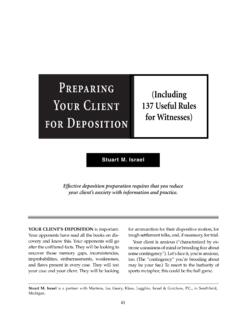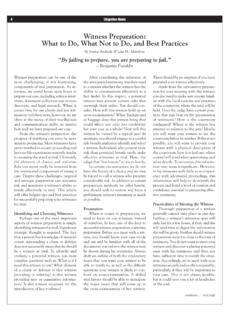Transcription of after that until your client hit me. - Shipman & Goodwin LLP
1 Hether representing aplaintiff or a defendantwe all know that our cli-ents deposition is a defen-sive exercise. Thus, in preparing clientsfor depositions, we explain the usualcautionary procedural guidelines: Say aslittle as possible, answer only what isasked, and dont volunteer goal is to have a deposition recordthat to the extent possible will not con-tradict the theory of the case we seekto prove at when preparing for trial, we spendhours, days, or even weeks going overthe substance of our clients ' testimonywith them. We review the facts and thedocuments in detail. We carefully craftthe most effective presentation of ourclients' direct testimony.
2 We preparethem for we prepare with such care for thesubstance of our clients ' testimony attheir depositions? I think not. Oughtwe to do so? I think we the Federal Rules of Civil Pro-cedure-and under many state practicestatutes-a partys deposition may beused at trial "for any purpose." Thismeans your clients deposition may beread to the jury even if the client testifiesat trial. Of course, your client 's deposi-tion may also be used for impeachmentpurposes. Accordingly, in preparing yourclient, you must assume that everythingsaid by the client will be read to the other words, your clients depositionis not merely preparation for the trialit is the trial.
3 Clearly, then, if your client is to be aneffective deposition witness- that is, awitness who does not harm the case- your preparation process must achievea union of substance and a loaf will be as bad as It RightSay you represent the plaintiff in anaccident case. On a rainy night, your cli-ent was driving under the speed limitwhen the defendant's car allegedly crossedthe double yellow line, hitting your cli-ents car on the drivers side. The keyissue is the location of the vehicles at thetime of impact, including who-if any-one-crossed the double yellow client has told you that a half-mile before the spot where the accidentoccurred-remember, it was raining-he skidded out of control and managedto stop his car in the left lane, narrowlyavoiding hitting the Elm Street have confirmed that Elm Street isabout one-half mile before the site ofthe collision.
4 after recovering from theskid, your client was driving with extracaution when the defendant careenedinto him without adversary knows or suspects thaton the night of the accident your clientskidded into the left lane. You knowyour adversary will try to show that theskid occurred at the time of the accidentand actually caused it. Thus, your clientwill have to be prepared for the inevit-able deposition question, "Isnt it trueMr. Plaintiff, that on the night of theaccident your car skidded across thedouble yellow line into the left lane?"If you prepare your client for deposi-tion with only the standard proceduralwarnings-like' 'Only answer the specif-ic question asked and nothing morehe may respond with a simple " every litigator knows that , despiteall the explanations in the world, ananswer like that , which will surely beread to the jury at trial, can be devastat-ing.
5 Even when your client explains attrial that the skid occurred a half-milebefore the accident site, the jury willwonder why your client did not say soat the deposition . The jury is likely toconclude that the explanation was madeup after the fact to save the if you have prepared your clienton the substance of the case as well ason the procedural guidelines of deposi-tion practice, the deposition will gomore like this:Q. Isnt it true, Mr. Plaintiff, that onthe night of the accident your car skiddedacross the double yellow line into theleft lane?A. Not at the time of the SO you dont deny that your carcrossed the double yellow line thatnight?
6 A. I dont deny it, but it didnt hap-pen at the time of the When do you claim it occurred?A. About half a mile before the siteof the accident, I skidded into the leftlane and narrowly avoided hitting astreet sign. I drove with extra cautionafter that until your client hit Now, Mr. Plaintiff, you cant besure that this skid occurred half a milebefore where the accident happenedcan you?A. I am quite sure of it. I have a vividrecollection oflooking up when my carcame to rest and seeing "Elm Streeton the street sign. I remember feelingrelieved not only that no car was com-ing the other way at the time, but alsothat I avoided hitting that street answers are as truthful as thesimple but dangerous "yes" responsebut they also reinforce your theory ofthe case and lay the foundation for yourproof at on Core IssuesHow do you prepare clients to givedeposition testimony like that above?
7 You prepare them on the cases core is-sues just as you would for core issues are those at the heartof the dispute-they are what the caseis all about. your client cannot be an ef-fective witness without a basic under-standing of what both you and your ad-versary are trying to prove. You cannoteffectively prepare your client on thecore issues unless you have first thor-oughly prepared yourself. You must besteeped in the cases legal and factual is-sues, you must be fully familiar with therelevant documents, and you must for-mulate your theory of the case-all be-fore meeting with your the deposition preparation ses-sion by having the client recount thekey facts of the case to you, in his orher own words and in chronologicalorder.
8 Direct the client to the fact issuesyou know are important, but be carefulnot to tell the client what to say. Ex-plain that it is important for you to havea complete and truthful explanation ofthe facts-good and bad-to representa client effectively. You should do thiseven if you reviewed the facts with yourclient earlier in the case. Remember, youwant to refresh your clients recollectionbefore the the facts are being recited, refreshthe client 's recollection with and aboutall relevant documents, making sure keydocuments are explained to you. Em-phasize documents that the witnesswrote, sent, received, reviewed, or reliedon. Dont be afraid to omit reviewingdocuments, no matter how voluminousTRIAL FEBRUARY 1993that do not involve the client .
9 For thosedocuments, a truthful "I dont knowanswer at the deposition will not doany your client recites the facts, ex-plain what the key disputed fact issuesin the case are and why they are legallysignificant. Frame these core issues byreferring to your clients recitation ofthe facts, using his or her actual wordswhere possible. Dont be too detailedor technical; your purpose here is simplyto give the client a rudimentary under-standing of the legal and factual crux ofthe dispute and of your theory of you have given your client aworking understanding of the core issues-and a refreshed recollection as to thekey facts and documents-you may be-gin the second half of the that an understanding of thecases substance does not, in itself, showyour client how to handle the deposi-tion process.
10 Thats what the procedur-al guidelines are word of caution before turning toprocedure. If you think you will be ableto wait until after the deposition processto identifY core issues and form a theoryof the case, you will have a rude awaken-ing: At that stage, the only issues andtheories left will be your adversaryProcedural Guidelines: Less Is MoreThe procedural guidelines for defen-sive deposition practice may be expressedin two fundamental rules. The first ruleTell the truth-is simple and has no ex-ceptions. The second rule-Dont vol-unteer-is complicated, requires expla-nation, and has the truth. Tell your client that youare serious about this rule; that the truthis what he or she must live with; andthat there is a case-or defense-if theclient tells the truth.












